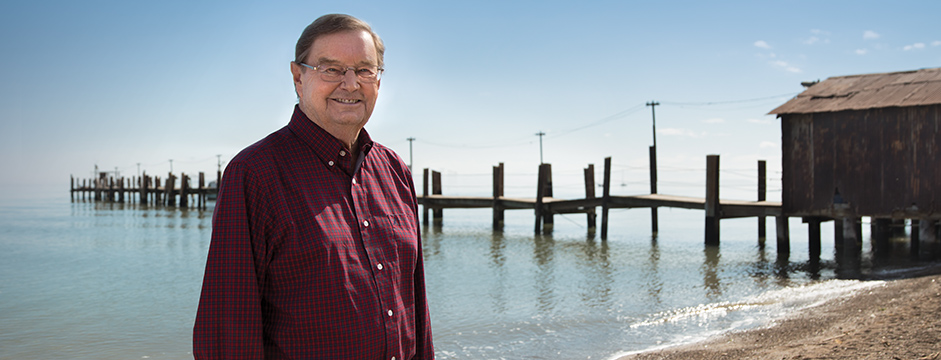John Irvine: Revolutionary New Pacemaker Changed His Life
Heart

80 year-old John Irvine is proud to call himself a Bay Area native. Born in San Francisco, John attended City College of San Francisco, graduated from UC Berkeley, and has lived in Marin for more than 50 years – most recently, Novato. He spent his career working for local canning giant Del Monte foods and still keeps in touch with fellow Del Monte retirees.
John lives alone and plans to maintain his independence as long as possible. Like many older adults, he was dealing with a few health issues, including the common trifecta: hypertension, high cholesterol, and type 2 diabetes. He was also anemic from chronic hemorrhoid-related bleeding, and had had a few bouts of atrial fibrillation (AFib). Still, John was healthy enough to walk two miles a day to stay fit. And then suddenly, he wasn’t.
John began experiencing shortness of breath in the summer of 2017. Soon, his 2-mile walk was too much for him so he reduced it to a mile, and then half a mile. The trouble persisted. John was worried, and then came the day that he “just didn’t feel right” and drove himself to the emergency room in Novato.
It took three trips to the hospital and multiple tests to get to the source of John’s breathing problems and chronic fatigue. John had blood transfusions and hemorrhoid surgery to deal with the anemia, but the fatigue and shortness of breath wouldn’t go away. Eventually, the problem was traced to John’s heart.
John had bradycardia, or slow heartbeat. A normal resting heartbeat is 60 to 100 beats a minute. In severe bradycardia, the heart beats so slowly that it doesn't pump enough blood to meet the body's needs. John’s heart was beating a perilously low 40 beats per minute. He had also gained 20 pounds of what turned out to be water weight. It was clear to Dr. Brian Keeffe that John was in immediate need of a pacemaker. He referred John to Sujoya Dey, MD, electrophysiologist and Medical Director of Electrophysiology at MarinHealth Medical Center (then Marin General Hospital).
This turned out to be the perfect referral because John was an ideal candidate for a revolutionary new pacemaker called the Micra™ Transcatheter Pacing System, or Micra TPS. MarinHealth Medical Center is one of very few Bay Area hospitals to offer the minimally invasive Micra procedure, and Dr. Dey is an early adopter of the procedure.
The traditional pacemaker requires an incision in the chest, just below the breastbone, where the pacemaker is implanted. Wires called leads transmit electrical impulses from the pacemaker to the heart, speeding up the heartbeat. While traditional pacemakers have helped many, they do have their disadvantages, the implantation procedure requires an incision and the placement of wires inside the heart. Recovery takes at least six weeks, during which patients need to avoid raising their arm or lifting anything heavier than five pounds. In most cases, the raised outline of the pacemaker remains visible under the skin.
The Micra™ is dramatically different. The capsule shaped device is only about as big as a large vitamin pill, one-tenth the size of conventional pacemakers. It is implanted endoscopically through a small incision in the groin and threaded up to the heart through the femoral vein. As Dr. Dey explained to John, there would be no incision in the chest, no pain, and no wires inside the heart because “the Micra™ has the brains and wires all in one.”
The Micra™ has few post implant activity restrictions, and cosmetically, patients appreciate that the implant is invisible. “There’s no sense of something under your skin,” Dr. Dey points out. “There’s no sense that something’s invaded your system. So just from a quality of life perspective, those things are different.”
John had his pacemaker implanted in early November of 2017, just a few days after meeting Dr. Dey. The procedure was remarkably uneventful. “It was nothing,” John marvels.” A very successful little venture. I was treated very well, it was quick, and the staff was terrific.”
After spending one night at MarinHealth Medical Center, John went home. The only precaution he was given was to avoid lifting anything heavier than ten pounds for the first week after the procedure. As for his fatigue and breathing issues, the improvement was immediate. “I got home and began to just walk around the house,” John recalls, “Walking up and down stairs and realizing that all of a sudden I was able to do things I wasn't able to do before, and without any effort! There was no recovery, I never felt a thing and to this day it's just fine.”
Today, John checks in with Dr. Dey every two to three months. He expects those visits to become fewer and farther between. Best of all, he no longer has shortness of breath and is once again walking the trails of his beloved Marin.
2020 Update: John Irvine passed away several years after this story was shared. His family is honored to have him remembered here and is thankful for the great care he received from MarinHealth.

